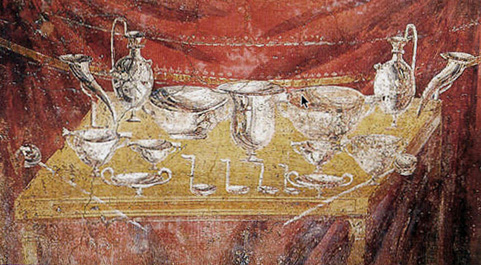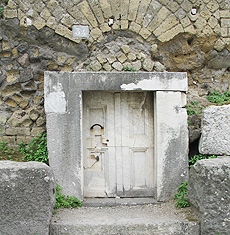 1
1House as Sanctuary – the Visual Evidence
It is a continuing testament to the sophistication of the wall-paintings that even today, despite their fragmented condition, they still manage to provide alluring glimpses into virtual worlds beyond the physical space of the house. In pristine condition their appeal must have been irresistible. But what did these alluring worlds consist of? A theme that is consistently depicted is that of the sanctuary. Perhaps one should not be too surprised by this because house design simultaneously provided physical and spiritual protection. This view is also supported by the iconography in the wall-paintings, which mainly consists of themes relating to struggle, resolution and the quest for the immortal afterlife. It is no coincidence that the eternal sanctuary (the domus aeterna or tomb) and the Roman house closely resembled one another. In Roman culture a house could be both a metaphorical stage and a repository for memories, both of which were echoed in its symbolic form, the tomb, the home for the dead. Since very ancient times the tomb was considered to be the eternal house and reproduced many of the internal and external features associated with houses, such as pediments and columns, beds, tables, chairs and even cooking facilities and utensils (fig.1). The exteriors of many Roman sarcophagi display architectural features such as house or temple facades (fig.2). The ancient terracotta pots that were used to contain human remains were invariably modeled to look like houses and thus became known as charnel houses (ossuary). Tomb monuments, such those found on the main thoroughfares leading into cities often resemble miniature houses or temples (fig.3-4). Collectively features such as these demonstrate the visual parallels that exist between the abode of the dead and the living. The need to create synergies between the house of the living and that of the dead may well have been given an extra impetus after the Roman state declared in-house burial illegal.
If, as is commonly believed, the tomb mirrored the house, then the tomb as the archetypal sanctuary reinforces the concept of the house as a sanctuary for the living, and through in-house ancestor worship, also that of the dead. The ceremonial honouring of the ancestors, both in the house and at the tomb, was a visible expression of household piety. The Roman concept of pietas consisted of state and family duty and public devotion to the gods and ancestors. Hence, the house was considered to be both a sanctuary for the living and the dead. (Lyttelton & Forman 1984:85).
This socio-symbolic view of the Roman house is seldom called upon to inform our understanding of the wall-paintings, which is surprising given that they are such a significant part of the intertextuality of the house as sanctuary. In part this omission is attributable to the type of research methodologies that were used to study them. To an almost exclusive extent the paintings were studied using typological methods that favoured separation and classification over evolution and intertextuality. As a result any semantic synergies that the paintings may have possessed were lost. This is typical of the problems that arise when stylistic identification and semantic significance are separated.
Another reason for not fully exploring the house as sanctuary premise has been the overriding emphasis on the relationship between the paterfamilias and the house. Powerful as he may have been he was clearly not the sole occupant. Nevertheless, his duties and his aspirations dominate the literature on the subject. The consequence of this has been a predominantly ‘outward’ view of the house and its function, characterised by owner display and visitor reception. In contrast, the ‘inward’ orientation experienced by its inhabitants has received very little attention. And yet, the inward orientation of the house is the major design feature that gives the house its sanctuary-like appearance, in conjunction with: entrance and threshold symbolism; in-house shrines; sacraria (sanctuary rooms); ritual banqueting; and wall-paintings depicting sanctuaries.
 1
1 4
4
|